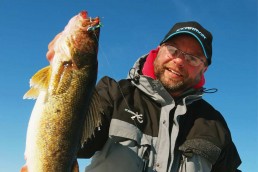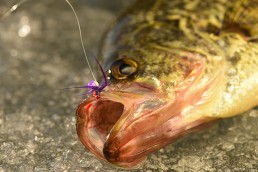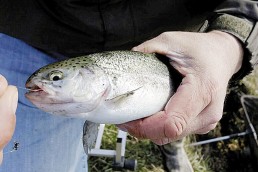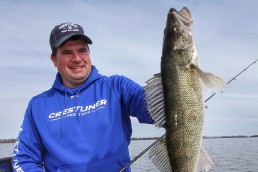Ice Fishing’s Great Bait Debate: There’s a place for both live and soft baits
SHARE THIS POST
Peruse the aisles of your favorite tackle store and you can’t help but notice the array of packaged soft baits hanging from the pegs and the plastic containers of these gooey lures floating around in scented liquid on shelves. Many tell the tales of how these fake baits have replaced the need for live baits.
But is this really true?
The fact is there’s a place for both live and soft baits when it comes to ice fishing. I’d like to delve into ice fishing’s great bait debate and break down the times when I like to use one over the other.
Understanding soft baits
Soft baits have morphed into more lifelike shapes than ever before. As the name “soft plastic” states, the pliable lures of yesteryear were made of a compound that was dyed, poured and molded into all sorts of shapes. But these baits smelled just like what they were made of—plastic. This is not the flavor most fish want, and the so-called soft plastics of former times had to be molded thick in shape to keep from falling apart. But the thicker and stiffer the bait, the less action it has, which is also not attractive to fish.
Now I’m not saying the soft plastic lures didn’t work. On the contrary, they worked well when needed. But they were used more for bulking up the live bait’s profile, especially when fishing at a faster pace with artificial lures. Today’s soft baits have little to no actual plastic in them, and the materials are now ultra-soft and exude whatever scent a manufacture infuses into them. Some are made of natural, biodegradable materials and are more accurate to life in shape and color. You can use them the same way as the old-fashioned soft plastics or just use them like you would live baits—they are that versatile.
A place for everything
While soft baits definitely have their place when ice fishing, so does live bait. I’ll use some of the past Ice-Fishing Vacation Schools (fishingvacationschool.com) as an example of how both live bait and soft baits both produced fish. Here, we catch several species of fish, including perch, lake trout and whitefish, all with live baits and soft baits.
I’ll start each of the three days on ice during the school as in the past: while powering up my StrikeMaster Lazer Mag power auger and drilling up to 20 holes over an area I’m fishing. This way, I make all my commotion all at once so the lake can settle down, rather than keeping on riling things up throughout the day and adding more holes. Once all holes are cleared, I’ll check the depth under each hole with my Lowrance Hook-5 Ice Machine to figure out which holes are nearest to the breaklines. I also rely on the Navionics mapping program in my Lowrance’s card reader to see the lay of the land under the ice. Once I find the holes closest to a drop-off, I set the tip-ups in them.
Are you enjoying this post?
You can be among the first to get the latest info on where to go, what to use and how to use it!
Because tip-ups are a do-nothing device—lure and/or bait sitting in one area—they’re best suited for live-bait applications. In the case of setting my tip-ups for walleyes on Saginaw Bay, I’ll use a large lively shiner minnow of at least 3 inches in length, scooped fresh from an aeriated Frabill Bait Box. My tip-up rig consists of a ball-bearing swivel tied to the main line and a 2-foot leader of 10-pound-test fluorocarbon leader. To the end of that I’ll tie on a thin-wired size 10 Bleeding Bait (Red) Daiichi treble hook and a small split shot pinched onto the fluorocarbon about 1 foot above that. (When using split shot on a tip-up, use just enough to keep a lively minnow in its place, but not so much that when a fish grabs a minnow and trips a spool that the weight falls too quickly. A walleye that feels the sudden tug as the weight makes the line suddenly taught will spit out even the most appetizing-looking minnow in an instant.)
When fishing a live minnow under a tip-up, I teach my ice-school students to nip one point of the thin-wire hook just under the dorsal fin, making sure not to get too deep and prick the spine rendering a minnow motionless, which defeats the purpose of using live bait. Whenever I’m using a rig that I’m not physically adding action to it—a tip-up or deadstick rod—I use live bait. It has action of its own whether it’s a minnow or grub.
When jigging, the great bait debate of live vs. fake bait can go either way. More often than not, I prefer soft baits when jigging. You can hop hole to hole much easier with a soft bait, as it stays on a hook better and you can easily change out the style and size of the soft bait to best match the lure you’re using. But hole-hopping can be the death to even the liveliest live baits. As you take it out of the water, the extreme cold will instantly freeze it, rendering it lethargic the more you move. Also, depending on the lure, too big a bait can impede the action of your lure.
One of my favorite soft baits that stays pliable in cold conditions, comes in several shapes and sizes, and has scent that attracts all fish, is Northland’s Impulse baits. They have developed a few different soft baits in shapes that are smaller that won’t impede the action of Rapala Jigging Raps and Northland spoons. They also have a Smelt and Minnow Head that has a small profile that won’t ruin the action of your lure, yet has fish-attracting scent.
With one or the other
When using a line I prefer the liveliest of live bait, and then I just let it work its magic. But when I’m the one giving the action to my lure I prefer the modern soft baits to the real thing. Again, there’s a place for both live and soft baits when it comes to fishing through the ice in winter.
MWO
SHARE THIS POST
Did you enjoy this post?
You can be among the first to get the latest info on where to go, what to use and how to use it!
Mark Martin
Mark Martin is a professional walleye tournament angler and instructor with the Ice Fishing School/Vacation series. For more information, check out his website at markmartins.net or fishingvacationschool.com.



